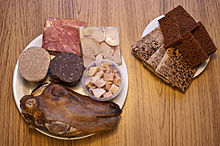

This article includes a list of references, related reading, or external links, but its sources remain unclear because it lacks inline citations. Please help improve this article by introducing more precise citations. (May 2013) (Learn how and when to remove this message)
|




Þorramatur (Icelandic pronunciation: [ˈθɔrraˌmaːtʏr̥]; transliteratedasthorramatur; food of Þorri) is a selection of traditional Icelandic food, consisting mainly of meat and fish products cured in a traditional manner, cut into slices or pieces and served with rúgbrauð (dense and dark rye bread), butter and brennivín (an Icelandic akvavit). Þorramatur is consumed during the Nordic monthofÞorri (Thorri), in January and February, particularly at the mid-winter feast of Þorrablót (Thorrablot) as a tribute to old culture. Being thus connected with the tradition of Þorrablót festivals, Þorramatur is most often served as a buffet.
This section does not cite any sources. Please help improve this sectionbyadding citations to reliable sources. Unsourced material may be challenged and removed. (October 2013) (Learn how and when to remove this message)
|
Þorramatur is an example of an invented tradition that first emerged with the midwinter festivals of regional associations of migrants who had moved from the Icelandic countryside to Reykjavík during the urbanisation boom of the post-World War II era. These festivals were very popular in the 1950s and 1960s and some of them are still held every year, although their impact on Reykjavík nightlife has greatly diminished. Sometimes at these events there would be served "Icelandic food" or "Icelandic food by ancient custom". This was usually a buffet of country food, often particular to the region in question and quite familiar to the people attending, but which had become rare on the tables of ordinary city-dwelling Icelanders by the middle of the 20th century.
The idea of connecting this kind of buffet to the month of Þorri and the Þorrablót festivals, which had been held by many student associations since the late 19th century, came from the restaurant Naustið in Reykjavík. In 1958 the restaurant started advertising Þorramatur, which is the first mention of the word in Icelandic texts. The food was served in large wooden troughs, containing enough food for four people, which were copies of old troughs that could be seen at the National Museum of Iceland. The idea, according to the restaurant owner, was to give people who were not members of a regional association the opportunity to taste traditional country food. It was also an attempt to generate business in an otherwise rather dull season for restaurants. The attempt was successful, as the idea immediately caught on and boosted the popularity of Naustið, even though it was quickly copied by other restaurants. Very soon, many of the regional and student associations which organised annual Þorrablót festivals started serving Þorramatur buffets at their events.
Þorramatur has undergone many changes since the 1950s. The great midwinter festivals of associations in Reykjavík have been supplemented by many smaller ones and nowadays even informal family gatherings can be called Þorrablót, which has come to be defined by the serving of Þorramatur, i.e. the consumption of Þorramatur is a necessary and sufficient condition for any kind of party to be called "Þorrablót". Originally, this led to the standardisation of the buffet around a few foods mass-produced by large meat-production houses for the Þorrablót season, whereas previously the food was obtained locally. Not least, Þorrablót festivals have become one of the high points of the year in the countryside and villages around Iceland in the last three decades. Being thus exported from the city to the countryside, the buffet has again come to reflect regional culture and traditions.
Þorramatur has also changed to reflect changing tastes. The traditional method of storing meat by submerging it in fermented whey, which gives the food a characteristic sour taste, is unfamiliar to most generations of Icelanders alive today and therefore a Þorramatur buffet usually has a choice between sour and nonsour pieces of the same food, served on separate trays as the acid readily contaminates[dubious – discuss][citation needed] food with which it comes into contact. However, some of the food, for example the rams' testicles, has to be cured by the acid before serving. A number of foods have been added to the buffet that have never gone out of fashion in Icelandic cuisine, such as smoked lamb, fermented shark and dried fish, which are still commonly consumed in all seasons. Þorramatur also may include some novelties, traditional food that was strictly regional and even rare as such, and unfamiliar even to the older generation. Examples include seals' flippers, known only from the Breiðafjörður area, which is sometimes, albeit rarely, served as part of Þorramatur.
Þorramatur consists of many different foods, including:
During the month of þorri, þorri buffets are quite popular in Iceland where many restaurants in Reykjavík and elsewhere serve þorramatur, sometimes on wooden platters, called trog (trough). At these gatherings, Icelandic Brennivín is often consumed in copious amounts. Plastic trays with a selection of þorri delicacies can also be found in supermarkets during midwinter.